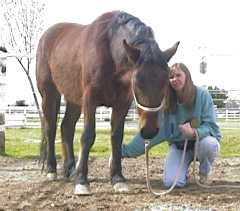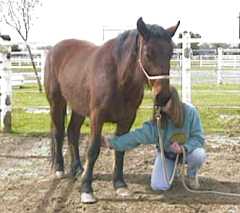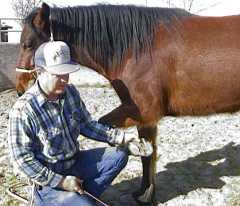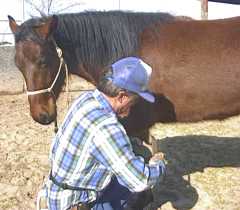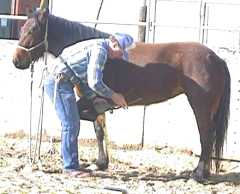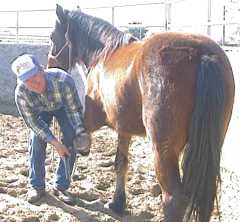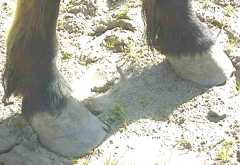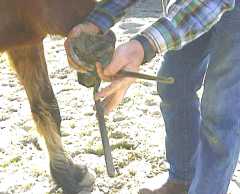Danny Love's Farrier's Corner

Teaching Your Horse to
Stand Quietly for the Farrier
Part Two
Using the Clicker Method
By Willis Lamm
With extremely nervous horses and recently adopted wild horses,
it may be a bit treacherous to just bend over and go after those
feet. These animals can easily get into a stress-feedback loop
and all too many times the farrier and horse get into a needless
battle from which the horse usually comes away regarding farriers
and others wanting to handle their feet and legs with suspicion and
disdain.
It's our opinion that horses with badly overgrown feet
shouldn't be run in the round and hazed to settle them down. If
they are not reasonably level, have long toes, and especially if
they have been standing around with little or no exercise, they
can get tendon sore being physically worked down to accept a trim.
Such activity can make the horse uncomfortable when asked to stand
and balance on three feet which can make trimming an even greater challenge.
BLM wild horses that are not sufficiently gentled can whip themselves
up very quickly if they feel trapped or they are stressed beyond
their tolerance limits, and therefore most farriers want the horses
tranquilized and dropped before working on them.
Since ungentled wild horses carry a fairly significant background
stress level, they don't tolerate being tranquilized very well and
can have serious or fatal side effects. For this reason we will
bring these unhandled horses in for a few days' gentling and desensitizing.
Then we will teach them to pick up their feet and we trim them standing.
We discovered while working a group of mustang mares which had badly
overgrown feet that
"operant conditioning" using
Clicker Training,
provided a very low stress and effective way
to condition a horse to accept having his legs and feet handled and worked on.
One advantage to clicker training is that the horse owner can safely
do a great deal of the preparation work prior to trimming day. The horse
can be taught to stand still, then to pick up a foot on cue.
Another element of clicker training is targeting. The horse learns to
target and touch an object on command. Thus the horse can target and
become familiar with the farrier's tools and chinks before he bends down
to go to work. This overall focusing of the horse's attention makes for
a much less stressful time for both horse and farrier.
Clicker training can be used to interrupt stress cycles in case the horse
starts getting nervous about the trimming operation. During the trim,
the horse owner can remain at the head and if the horse gets
anxious, the horse's attention can be refocused and positive behavior
(relaxation and cooperation) can be rewarded.
In our experiments with the wild horses, virtually as soon as we could
handle their legs, we could get them to pick up and stay relatively calm
through an entire trim without "locking in" or struggling.
Furthermore in virtually all cases, we got to the point during the first
trim where we could literally drop the lead line or I could tuck it into
my belt. The horse was relaxed and accepting of the trim work and an
occasional look back to see what was going on seemed to satisfy them.
With one mare her hinds were so uneven (medially short, laterally very
long) that she could not balance herself when one hind was raised. She
actually fell over on one attempt. With click targeting, Sharon who was
at the head could draw her head around toward the opposite side which helped
counterbalance the mare. Being drawn rather than forced around, she
stayed loose in the neck and didn't spook at the activities going on at
her hind end.
I don't like to "lock in" on a barely gentled horse. My back isn't
in good enough condition for a bent over struggle and these horses can
incite into great ferocity very easily when they feel trapped. Using
clicker conditioning, the horses will lay their pasterns across my knee
when I need to use both hands on the nippers, and generally won't take
their feet back unless I place them on the ground.
Continue to:
| 